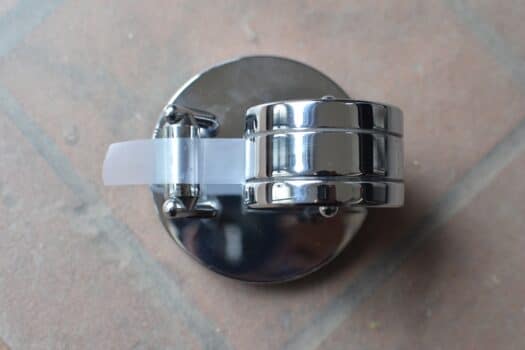Are you tired of the dull-looking aesthetics of plastic surfaces? Then, you can change that with some chrome spray paint.
To be honest, chrome paint is capable of providing one of the best finishes available today. Its distinctive mirror-like appearance can drastically improve the look of the surface on which it is applied.
In most cases, chrome paint is used for metal exteriors. But, you’ll be glad to know that the chrome plating technique is versatile enough to be used on surfaces like wood, ceramic, and even plastic.
The last one is of particular interest, considering how common plastic items are today. However, if you do not know how to go about chrome plating plastic, then fret not. We have addressed this aspect in this short guide.
So, let’s begin!
How To Paint Chrome On Plastic?

If you are somewhat familiar with paints and finishes, then you will know that chrome is not actually a separate color. It is a finish, so it can technically be applied over other colors to make them highly reflective.
The same principle is used for plastic chrome plating as well. You will need to spray chrome on plastic parts to give them a metallic sheen. However, the technique is not very flexible in nature, so we would recommend using it on rigid plastics only.
When you use it on flexible plastics, the chrome will be subjected to a lot of stress due to the elastic nature of the plastic. As a result, the chrome finish may crack or start to peel off over time.
Besides, to go about plastic chrome plating, you will need to follow a proper procedure, or else you may not achieve the desired paint finish.
As such, you might be thinking, “how do I make paint look like chrome on plastic?” In that case, we suggest you continue reading.
1. Disassemble The Plastic Parts
First off, you will need to dismantle the plastic pieces that you wish to paint chrome. You should do this step to make the process more convenient and avoid spray painting on adjacent surfaces that are not to be painted.
However, if you intend to paint the whole surface, then this step will not be necessary.
2. Cleaning And Degreasing The Parts
After you have removed the pieces, you should clean and degrease them. For this purpose, you will need to use a soap and water solution. Mix a little bit of liquid soap or detergent in a bucket of water. Then, dampen a clean cloth or sponge in the soapy water, and use it to clean the plastic parts.
You need to make sure that the surface is sufficiently clean without any trace of dirt and grime. Also, there should not be any grease deposits left on the plastic piece, as that can hamper the paint adhesion. You can use a specialized degreasing spray in addition to soapy water to eliminate any oily residues. Once you are done, you need to let it dry before proceeding further.
3. Scrub The Plastic Surface
Scrubbing is a crucial step in the process of painting your plastic chrome. Here you will need to scrub the plastic surface with a brush or a scuffing pad. We also suggest using a bit of scuffing paste and water, which will prevent leaving behind any unsightly scuff marks.
Put a little bit of the paste on the plastic and gently scrub the surface with a brush or scuffing pad. Remember to keep it moist by pouring small amounts of water during the scrubbing process.
This will ultimately remove any irregularities on the plastic surface and make it smooth enough to apply primer and paint. Following that, you should wash the plastic under running water to remove any loose debris or excess paste.
4. Apply Primer
The next step is to apply a clear coat of primer to the plastic surface. This will allow the chrome plastic parts to adhere well to the paint. It will also protect the surface against scratches and damage after the painting process is done.
If possible, you should use a spray gun to distribute the primer evenly over the plastic. Make sure to keep the spray gun at a sufficient distance to avoid over-spraying on a single spot. You can apply more than one layer of primer, but make sure you dry the surface after applying each layer.
5. Apply Paint And Chrome Finish
Once you have primed the surface, it is time to apply the base coat of paint. For this, you can use any high-quality acrylic enamel, which is the most appropriate choice for painting chrome plastic. As for the color, you can choose any shade that you prefer.
Ideally, we would recommend using a darker shade to complement the metallic sheen of chrome. But, you can choose a lighter shade, too, if you wish.
You can either spray the paint on the plastic or use a brush. Regardless of how you choose to apply it, you need to dry the plastic surface before using chrome spray paint. After it has dried, you can safely apply the chrome finish.
Both for the color and chrome, we suggest that you apply more than one layer to get a denser finish. And you should give sufficient time for the previous layer to dry before you apply the next one. After the last layer, let it stand for a few hours to give the paint enough time to dry and be ready for the next step.
6. Apply A Paint Sealer
To provide additional protection and durability to the paint, apply a paint sealer over the dried chrome. Not only that, but the paint sealer will also help make the finish glossier.
You need to apply the sealer over a completely dry surface. We’d suggest applying a thick layer of paint sealer to achieve the best results, but that will increase the drying time slightly. You can finish off by buffing the plastic with a polishing pad.
Things To Consider While Painting Chrome On Plastic
Before you start the paint job, keep some things in mind to make the process safe and easy. The most important aspect among them is to use protective gear. Chrome paint is made from chemicals that are toxic for the human body.
So, make sure you always wear a mask, goggles, head cover, and gloves to avoid coming in direct contact with the paint or inhaling its fumes. You should also paint in a well-ventilated area to allow the fumes to escape. Not only that, but it will also allow the dust generated from the scrubbing process to escape.
Another critical aspect to keep in mind is to not rush through the painting process. You should dedicate enough time to the job, or else you might not be satisfied with the end results. So, always provide sufficient time for the different tasks, such as scrubbing, cleaning, and drying.
Chrome Paint On Plastic Frequently Asked Questions ?
Can you powder-coat chrome on plastic?
Powder chrome is often used as a spray painting medium. In fact, it is the best spray paint for rims, exhausts, and other automotive parts. However, you cannot use it for plastic because the curing process for powder chrome spray painting involves heat treatment, which can damage it.
Is chrome durable when used on plastic?
If you use a spray over acrylic enamel paint, the chrome will stick to plastic fairly well. However, like most paint, it is susceptible to wear with usage. So over time, it may become dull or start flaking or peeling off. Although, you can minimize the latter if you use sufficient primer and paint sealant.
Can you use a chrome wrap on plastic?
Yes, you can use chrome wrap on plastic as a suitable alternative. Chrome wraps usually involve covering the plastic with a thin, stretchable chrome film. In this regard, it is a relatively faster process than using spray paint. But, be advised that the chrome film can get torn or scratched easily. Besides, it may not have the same sheen as chrome spray paint.

Chrome Paint On Plastic Final Words
That is all we had to say about painting chrome on plastic. So, the next time you feel like spraying chrome paint onto any plastic material, you can use the information we have provided here.
Of course, if you feel unsure about doing it yourself, you can always get help from some of the professional painting services available today. With that said, it is time for us to wrap up our brief guide. We’ll be back with more such updates.
Until then, goodbye!


